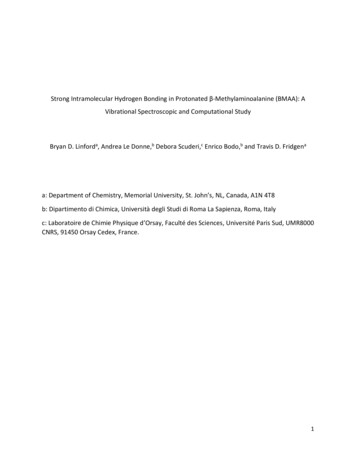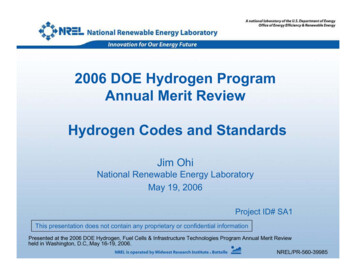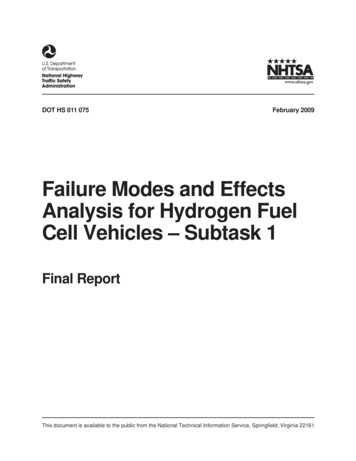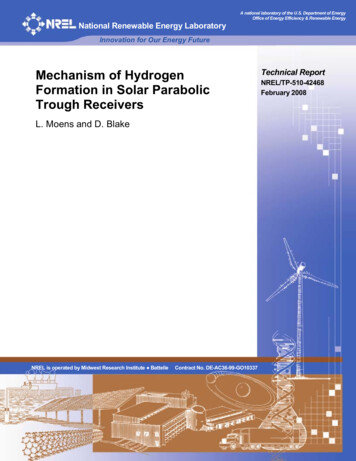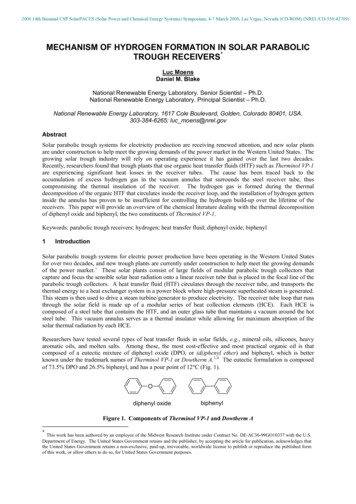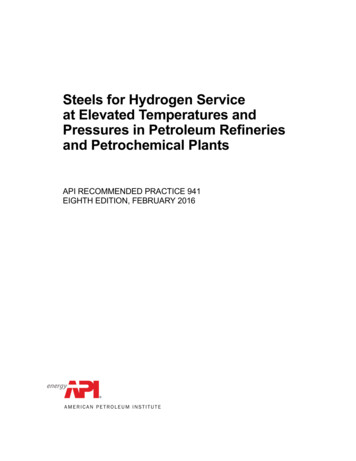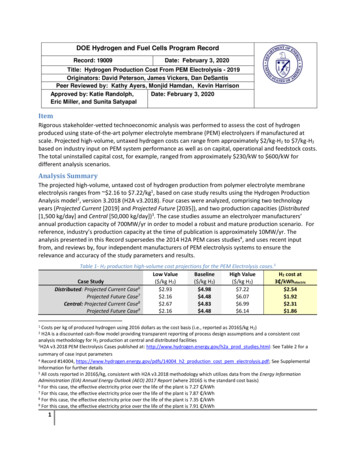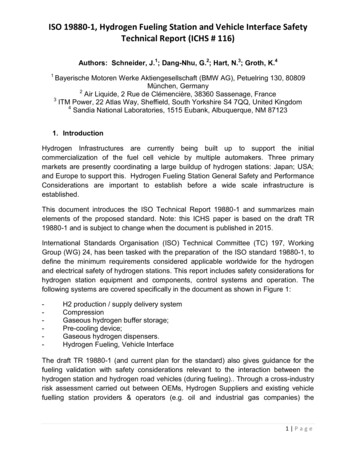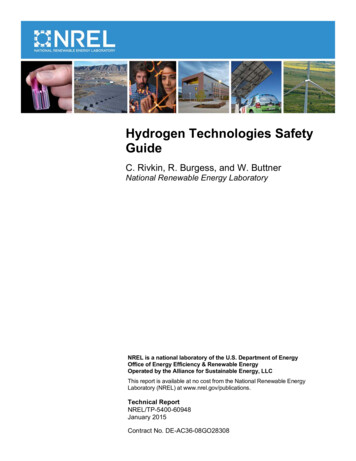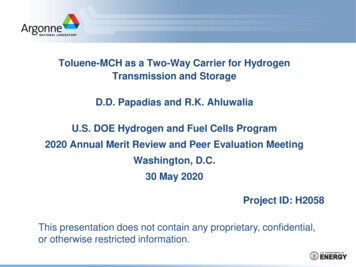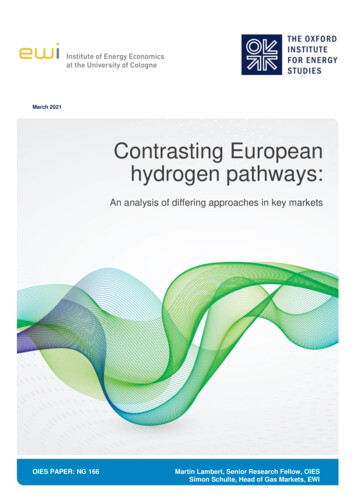
Transcription
March 2021Contrasting Europeanhydrogen pathways:An analysis of differing approaches in key marketsOIES PAPER: NG 166Martin Lambert, Senior Research Fellow, OIESSimon Schulte, Head of Gas Markets, EWI
The contents of this paper are the authors’ sole responsibility. They do notnecessarily represent the views of the Oxford Institute for Energy Studies, theInstitute of Energy Economics at the University of Cologne or any of its members.Copyright 2021Oxford Institute for Energy Studies(Registered Charity, No. 286084)This publication may be reproduced in part for educational or non-profit purposes without specialpermission from the copyright holder, provided acknowledgment of the source is made. No use of thispublication may be made for resale or for any other commercial purpose whatsoever without priorpermission in writing from the Oxford Institute for Energy Studies.ISBN 978-1-78467-155-6March 2021: Contrasting European hydrogen pathwaysii
Contents1.2.3.4.5.6.7.8.9.Introduction . 1Overview and Comparative Analysis . 22.1.Policy drivers by country . 22.2.Hydrogen Demand . 32.3.Hydrogen Supply . 52.4.Summary Conclusion . 12France . 133.1.Policy Framework . 133.2.Hydrogen Demand . 143.3.Hydrogen Supply . 17Germany . 194.1.Policy Framework . 194.2.Hydrogen Demand . 214.3.Hydrogen Supply . 24Italy. 275.1.Policy Framework . 275.2.Hydrogen Demand . 285.3.Hydrogen Supply . 29Netherlands . 306.1.Policy Framework . 306.2.Hydrogen Demand . 316.3.Hydrogen Supply . 32Spain . 347.1.Policy framework . 347.2.Hydrogen Demand . 357.3.Hydrogen Supply . 38United Kingdom . 398.1.Policy Framework . 398.2.Hydrogen Demand . 408.3.Hydrogen Supply . 42Conclusion . 43Annex . 45March 2021: Contrasting European hydrogen pathwaysiii
FiguresFigure 1: Comparison of hydrogen strategies and policy drivers by country . 2Figure 2: Current (2018) natural gas (left) and hydrogen (right) demand by country . 3Figure 3: FCH JU low and high scenarios for 2030 hydrogen demand by sector and country . 5Figure 4: LCOH for green hydrogen production for selected RES technologies and regions by 2030 . 7Figure 5: LCOH for green hydrogen production for selected RES technologies and regions by 2050 . 7Figure 6: Comparison of natural gas-based and RES-based hydrogen production in 2030 (left) and2050 (right) based on Brändle et al. . 10Figure 7: French heating sector by source . 16Figure 8: Current hydrogen production by technology in France. 17Figure 9: German hydrogen consumption as estimated in different scenario studies . 22Figure 10: LCOH and cost benchmarks on the demand side in Germany in 2019 . 25Figure 11: Final energy consumption in Germany in 2050; technology mix scenario with 95 per centcarbon emission reduction . 26Figure 12: Italy potential hydrogen demand by sector . 28Figure 13: NL Hydrogen use by application in petajoule (PJ) in 2019 Source . 31Figure 14: Estimated 2019 hydrogen supply by industrial cluster . 33Figure 15: UK total hydrogen demand by scenario . 41Figure 16: Hydrogen demand by sector and scenario . 42TablesTable 1: FCH JU assumed penetration in 2030 of low carbon hydrogen by country and sector . 4Table 2: Electricity system characteristics of individual countries . 9Table 3: Comparison of the CO2, natural gas and hydrogen infrastructure of the selected Europeancountries . 11Table 4: Final energy consumption for natural gas in 2018 . 14Table 5: Final energy consumption for natural gas in Germany in 2018 . 21Table 6: Final energy consumption for natural gas in Italy in 2018 . 28Table 7: Final energy consumption for natural gas in the Netherlands in 2018 . 31Table 8: Final energy consumption for natural gas in Spain in 2018 . 36Table 9: Final energy consumption for natural gas in the UK in 2018 . 40Table 10: Key features of UK National Grid Future Energy Scenarios 2020 . 41March 2021: Contrasting European hydrogen pathwaysiv
1. IntroductionThe year 2020 will be remembered as the year when the Covid-19 pandemic swept the world, but it hasalso seen increasing momentum behind the urgency of tackling the longer-term global challenge ofclimate change, with more and more countries making pledges to achieve "net-zero" emissions. TheUK and France started in mid-2019 with targets to achieve net-zero by 2050, but perhaps the mostsignificant development in 2020 was the pledge by China to achieve net-zero by 2060.In this context, there has also been growing momentum behind the view that low-carbon hydrogen willplay a significant role in the decarbonisation of the energy system. Decarbonisation will certainly leadto a significant increase in the role of electricity, with it perhaps meeting over 50 per cent of final energydemand by 2050, compared with typically around 20 per cent today. Currently, the remaining 80 percent of final energy demand is provided by molecules like oil, gas, and coal. There will still be asignificant role for molecules as well as electrons in the future decarbonised world. Since the unabateduse of fossil fuels will not be consistent with net-zero targets, low-carbon, or preferably zero-carbon,hydrogen will be required. Further details on the potential for hydrogen and some of the challenges,particularly around cost and scale, have been covered in previous OIES and EWI papers publishedduring 2020.1In Europe, the EU published its Hydrogen Strategy2 in July 2020, closely linked to its Energy SectorIntegration Strategy. Several European countries have also published their own hydrogen strategiesduring 2020 (e.g. Netherlands, Norway, Portugal, Germany, France, and Spain). While other countries(e.g. Italy and the UK) have not yet finalised formal strategies, they are actively developing plans forhydrogen to play a role in the energy transition. Outside Europe, several other countries have alsopublished hydrogen strategies.3While it is relatively straightforward to publish a document setting out a strategy, it is likely to besignificantly more challenging to put in place the required budgets, incentives, and regulatory structuresto enable the required investments to proceed within the aspired timetables. In this paper, we examinethe intended hydrogen pathways in six key Western European markets and compare the approachesbeing developed in each of those countries. The selected countries are France, Germany, Italy,Netherlands, Spain, and the UK, chosen since they are all significant current natural gas markets andall are envisaging a significant role for hydrogen in the energy transition. It is notable that while all havesimilar ambitions and (apart from the UK) are all part of the EU, there are different approaches beingdeveloped in each country. It is likely that the use of molecules in the decarbonised energy system willvary by country and region, perhaps to a greater extent than the rather homogenous natural gas marketacross Europe today.The paper is structured with an initial summary section (Section 2) with some overall themes andcomparisons between the individual countries. This is followed by sections on each country arrangedin alphabetical order, for those readers who would like more detail on each country. Each section is1Lambert (2020a) -of-Gas.pdf , Dickel (2020): drogen-the-case-of-Germany-NG-159.pdf, Barnes/Yafimava gulatory-opportunitiesand-challenges.pdf, Schlund/Schulte/Sprenger (2021) /2021/03/EWI WP 21-02 The Whos who of a hydrogen market ramp-up Schlund Schulte Sprenger.pdf,Brändle/Schönfisch/Schulte (2020) s/2020/11/EWI WP 2004 Estimating long-term global supply costs for low-carbon Schoenfisch Braendle r/Mansius (2020) regulationhydrogen-networks/ and Schulte/Schlund (2020) sion/presscorner/api/files/attachment/865942/EU Hydrogen Strategy.pdf.pdf3See, for example, 020/10/WEC H2 Strategies ExecutiveSummary final.pdf for a summary description of the content of each strategy document.March 2021: Contrasting European hydrogen pathways1
structured with an initial consideration of relevant policy, followed by sections on current and potentialhydrogen demand and then supply. Finally, Section 9 draws some overall conclusions.2. Overview and Comparative AnalysisSections 3 to 8 below review the current state of the hydrogen market
Netherlands, Spain, and the UK, chosen since they are all significant current natural gas markets and all are envisaging a significant role for hydrogen in the energy transition. It is notable that while all have similar ambitions and (apart from the UK) are all part of the EU, there are different approaches being developed in each country. It is likely that the use of molecules in the .
